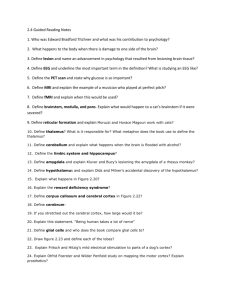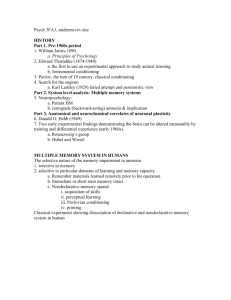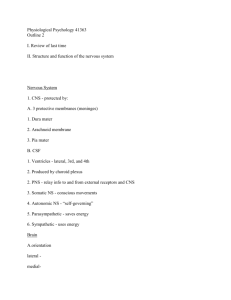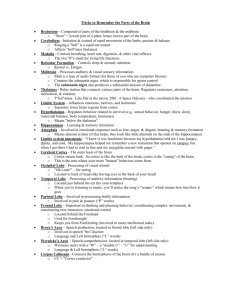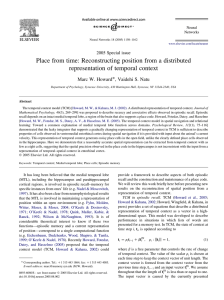Chapter 2. Studies of human learning and memory
advertisement
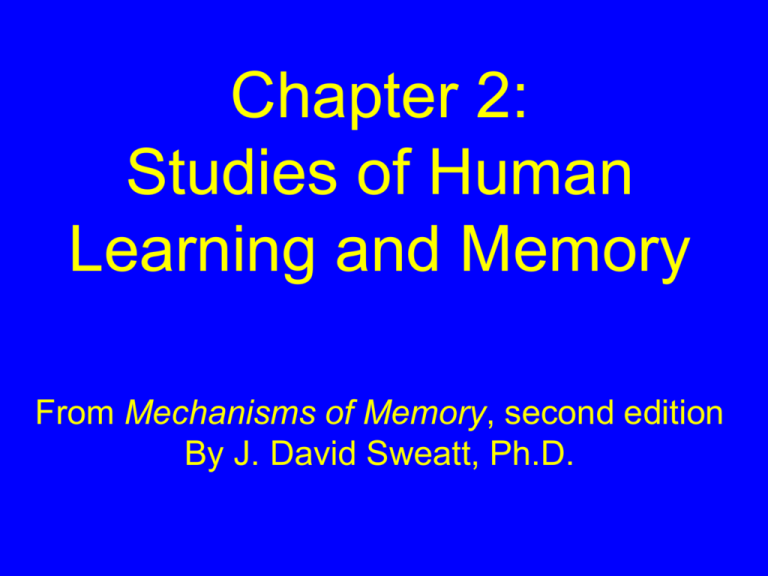
Chapter 2: Studies of Human Learning and Memory From Mechanisms of Memory, second edition By J. David Sweatt, Ph.D. Medium Spiny Neuron A Current Conception of the major memory systems in the brain Figure 1 Major Brain Regions and Temporal Lobe System Figure 2 Hippocampal Connectivity in the CNS Somatosensory Visual Sensory Regions Of Cortex Olfactory Auditory Perirhinal/ Entorhinal Cortex Hippocampal Formation Figure 3 Perirhinal Cortex Entorhinal Cortex CA3 Dentate Gyrus CA1 Hippocampal Pyramidal Neuron Figure 4 Hippocampal Output Pathway & Intrinsic Circuit A B Entorhinal Cortex CA1 CA3 Perforant Pathway Dentate Gyrus Entorhinal Cortex CA1 Outputs Mossy Fibers C CA3 CA1 Axon Schaffer Collaterals GABAergic Interneuron CA1 Norepinephrine Amygdala, Cortex Subiculum/ Entorhinal Cortex Lateral Septum Figure 5 Acetylcholine Serotonin Schaffer Collaterals MRI scan of H.M. and control brain H.M. Figure 6 Control MRI of HM’s Brain lesions Surgeon’s Estimate of H.M.’s lesions Figure 7 Revised Estimate based on MRI Virtual Reality Town used in episodic memory studies E Figure 8 F London Taxi driver study A B Figure 9 Excellence in motor learning and memory Figure 10 Summary Scheme of interaction between motor centers Figure 11 Basal Ganglia in the Human Brain Figure 12 The Striatal Motor Learning System Cortex Motor Pre-Frontal (Sensory) Pre-Motor Striatum Substantia Nigra Caudate/Putamen/ Accumbens Globus Subthalamic Pallidus Nucleus Thalamus Ventral Anterior & Ventral Lateral Nuclei Figure 13 Rajan Srinavasen Mahadevan Figure 14 1000 Decimal places of pi 3.14159265358979323846264338327950288419716939937510582097494459 2307816406286208998628034825342117067982148086513282306647093844 6095505822317253594081284811174502841027019385211055596446229489 549303819644288109756659334461284756482337867831652712019091456 485669234603486104543266482133936072602491412737245870066063155 8817488152092096282925409171536436789259036001133053054882046652 1384146951941511609433057270365759591953092186117381932611793105 1185480744623799627495673518857527248912279381830119491298336733 624406566430860213949463952247371907021798609437027705392171762 931767523846748184676694051320005681271452635608277857713427577 896091736371787214684409012249534301465495853710507922796892589 2354201995611212902196086403441815981362977477130996051870721134 999999837297804995105973173281609631859502445945534690830264252 2308253344685035261931188171010003137838752886587533208381420617 1776691473035982534904287554687311595628638823537875937519577818 577805321712268066130019278766111959092164201989…. Figure 15 Kim Peek Figure 16 Neuroimaging of the retrieval of the Spatial Context of an Event Blue Box 1 Movies Using Amnesia as a Plot Device Movie Director (plus Notable Actors) Year Anterograde Amnesia: Memento Christopher Nolan (Guy Pearce) 2001 Finding Nemo Andrew Stanton (Animated - Ellen DeGeneris as Dory) 2003 50 First Dates Peter Segal (Adam Sandler) 2004 Retrograde Amnesia: The Bourne Identity Doug Liman (Matt Damon) 2002 Total Recall Paul Verhoeven (Arnold Schwarzenegger, Sharon Stone) 1990 Spellbound Alfred Hitchcock (Ingrid Bergman, Gregory Peck) 1945 Eternal Sunshine of the Spotless Mind Michel Gondry (Jim Carrey, Kate Winslet) 2004 The Forgotten Joseph Ruben (Julianne Moore) 2004 Men in Black Barry Sonnenfeld (Tommy Lee Jones, Will Smith) 1997 Not Sure: Mulholland Drive David Lynch (Michael J. Anderson, Diane Baker) 2001 Table 1 Multiple Memory Systems in the Human CNS Memory Subtype Working Memory Corresponding CNS Subregion Prefrontal Cortex, contributions from Caudate Nucleus Declarative, Episodic, and Spatial Memory Medial Temporal Lobe system including the Hippocampus, Dentate Gyrus, Ento-rhinal and Perirhinal cortices Habits, Motor Skills, Procedural Memory Striatum (Caudate Nucleus and Putamen), Globus Pallidus*, and Cerebellum Priming Occipital Cortex, Neocortex in general Aversive Associative Conditioning Amygdala Motoric Associative Conditioning Cerebellum Olfactory and Taste Conditioning Olfactory Bulb, Insular Cortex, Nucleus Tractus Solitarius (NTS), positive and negative reinforcement systems (Amygdala or Nucleus Accumbens) Sensitization, Habituation Spinal Cord, Brainstem Nuclei, Amygdala Circadian Rhythm Hypothalamus – Suprachiasmatic Nucleus (SCN) Reward, Positive Reinforcement, Addiction Nucleus Accumbens, Ventral Tegmental Area (VTA) *Collectively the Caudate Nucleus, Putamen, and Globus Pallidus are referred to as the Basal Ganglia. Table 2 Memory-associated Cognitive Dysfunction in Humans Disease or Syndrome Type of Memory Affected or Involved* Likely Anatomical Locus Schizophrenia Working Memory Prefrontal Cortex Major Depression Declarative Memory ? Aging-related Dementias Long-term Declarative and Episodic Memory Temporal Lobe Hippocampal System Korsakoff’s Syndrome (Alcoholism, Malnutrition) Long-term Declarative and Episodic Memory Mamillary Bodies, Limbic System, Thalamus Huntington’s Disease and Parkinson’s Disease Motor Learning, Habit Learning Nigro-striatal System Attention Deficit Generalized or Specific Learning Frontal Lobes? Hyperactivity Disorder (ADHD) Disabilities, Dyslexia Basal Ganglia? Post-traumatic Stress Disorder* (PTSD) Aversive Associative Conditioning, Lack of Extinction Amygdala, Hippocampus Table 3 Major Neurotransmitters in the Hippocampus Table 4 Neurotransmitter Abbreviation, Synonym General role Serotonin 5HT, 5-hydroxytryptamine neuromodulation Dopamine DA neuromodulation Acetylcholine ACh neuromodulation Norepinephrine NE neuromodulation Gamma-amino Butyric Acid GABA inhibitory transmission Glutamate Glu excitatory transmission
